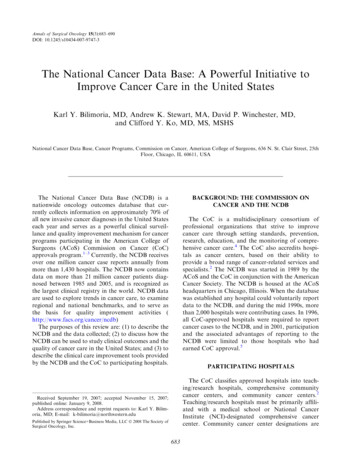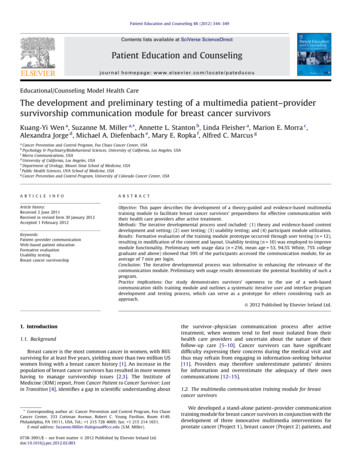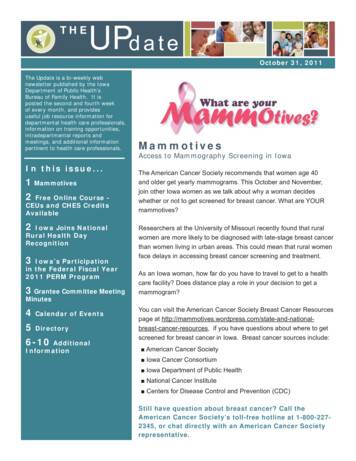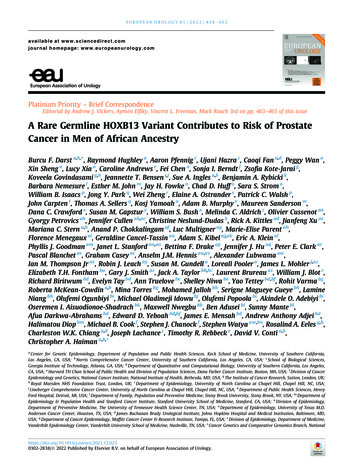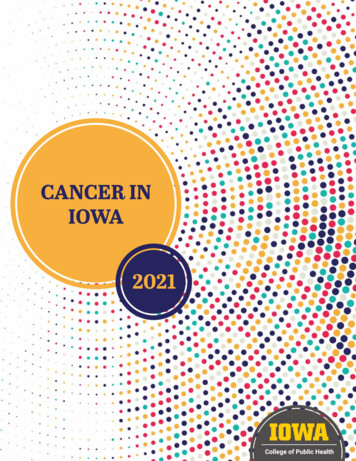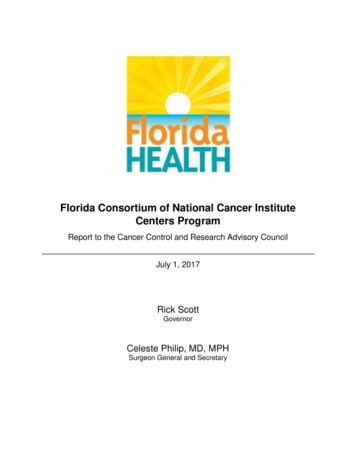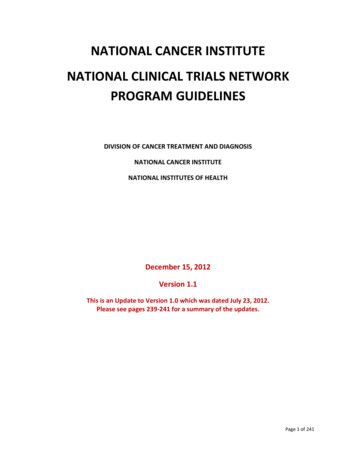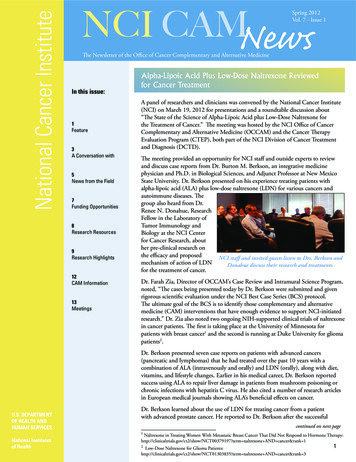
Transcription
National Cancer InstituteNCI CAMNewsSpring 2012Vol. 7 - Issue 1The Newsletter of the Office of Cancer Complementary and Alternative MedicineIn this issue:1Feature3A Conversation with5News from the Field7Funding Opportunities8Research Resources9Research Highlights12CAM Information13MeetingsAlpha-Lipoic Acid Plus Low-Dose Naltrexone Reviewedfor Cancer TreatmentA panel of researchers and clinicians was convened by the National Cancer Institute(NCI) on March 19, 2012 for presentations and a roundtable discussion about“The State of the Science of Alpha-Lipoic Acid plus Low-Dose Naltrexone forthe Treatment of Cancer.” The meeting was hosted by the NCI Office of CancerComplementary and Alternative Medicine (OCCAM) and the Cancer TherapyEvaluation Program (CTEP), both part of the NCI Division of Cancer Treatmentand Diagnosis (DCTD).The meeting provided an opportunity for NCI staff and outside experts to reviewand discuss case reports from Dr. Burton M. Berkson, an integrative medicinephysician and Ph.D. in Biological Sciences, and Adjunct Professor at New MexicoState University. Dr. Berkson presented on his experience treating patients withalpha-lipoic acid (ALA) plus low-dose naltrexone (LDN) for various cancers andautoimmune diseases. Thegroup also heard from Dr.Renee N. Donahue, ResearchFellow in the Laboratory ofTumor Immunology andBiology at the NCI Centerfor Cancer Research, abouther pre-clinical research onthe efficacy and proposedNCI staff and invited guests listen to Drs. Berkson andmechanism of action of LDNDonahue discuss their research and treatments.for the treatment of cancer.Dr. Farah Zia, Director of OCCAM’s Case Review and Intramural Science Program,noted, “The cases being presented today by Dr. Berkson were submitted and givenrigorous scientific evaluation under the NCI Best Case Series (BCS) protocol.The ultimate goal of the BCS is to identify those complementary and alternativemedicine (CAM) interventions that have enough evidence to support NCI-initiatedresearch.” Dr. Zia also noted two ongoing NIH-supported clinical trials of naltrexonein cancer patients. The first is taking place at the University of Minnesota forpatients with breast cancer1 and the second is running at Duke University for gliomapatients2.Dr. Berkson presented seven case reports on patients with advanced cancers(pancreatic and lymphomas) that he had treated over the past 10 years with acombination of ALA (intravenously and orally) and LDN (orally), along with diet,vitamins, and lifestyle changes. Earlier in his medical career, Dr. Berkson reportedsuccess using ALA to repair liver damage in patients from mushroom poisoning orchronic infections with hepatitis C virus. He also cited a number of research articlesin European medical journals showing ALA’s beneficial effects on cancer.U.S. DEPARTMENTOF HEALTH ANDHUMAN SERVICESDr. Berkson learned about the use of LDN for treating cancer from a patientwith advanced prostate cancer. He reported to Dr. Berkson after the successfulcontinued on next page1National Institutesof HealthNaltrexone in Treating Women With Metastatic Breast Cancer That Did Not Respond to Hormone 9197?term naltrexone AND cancer&rank 12Low-Dose Naltrexone for Glioma 03835?term naltrexone AND cancer&rank 31
from previous pageDr. Burton Berkson discusses his cases ofpatients treated with alpha-lipoic acid(ALA) plus low-dose naltrexone (LDN).therapy with LDN of both the patient’scancer and rheumatoid arthritis (RA).Subsequently, Dr. Berkson offeredLDN to his patients with RA and otherautoimmune diseases. “Within abouta month, most of the patients were offall drugs and feeling completely normalon just LDN, at 15 a month,” herecalled. In his presentation of the casereports, Dr. Berkson reported uniformlypositive responses and low toxicity fromthe ALA/ LDN regimen for each ofthe seven cancer patients. Of the sevencases presented by Dr. Berkson, four hadpathology specimens reviewed throughthe NCI Best Case Series protocol.NIH and NCI specialists in radiologicalimaging (Dr. Elizabeth Jones) andpathology (Dr. Avi Rosenberg) reviewedthe available medical imaging studies andpathology slides of the four cases. Of thefour cases reviewed, three had confirmedpathologic diagnosis while one had adiagnosis that could not be definitivelyconfirmed.Dr. Berkson commented, “I try todiscourage many cancer patients who callmy office because I’m not an oncologist;however, I do work with cancer patientswho are also seeing an oncologist.”He acknowledged that the ALA/LDNprotocol works better for rheumatoiddisease, “but I think it deserves sometype of clinical trial in cancer patients aswell.”Dr. Gregory Plotnikoff, from AllinaHospitals System in Minneapolis,Minnesota reported that his hospitalhas 36 advanced cancer patients usingLDN with and without ALA on a2compassionate-use basis as well as anopen-label study of the LDN treatmentfor aromatase inhibitor-induced painin breast cancer. “The oncologists thereare intrigued and anxious to do rigoroustrials because they believe that there issomething here that they have not seenfrom any other therapies,” he said.Dr. Donahue presented findings fromher research as a doctoral graduatestudent at the Penn State College ofMedicine in the lab of Dr. Patricia J.McLaughlin and Dr. Ian S. Zagon. Thelab’s research focused on the role of thecellular peptide opioid growth factor(met5-enkephalin) – or OGF – and theOGF receptor (OGFr) axis in cancer andautoimmune diseases.“Our initial studies have shown thatif you block the interaction betweenOGF and OGFr with an opioid receptorantagonist, such as naltrexone, youget an increase in cell proliferation,”Dr. Donahue reported. “However,subsequent studies have shown that ifyou use a lower dose of opioid receptorantagonist, such as LDN, you actuallyget the opposite effect, a decrease in cellproliferation.”Dr. Renee N. Donahue discusses herresearch on low-dose naltrexone.Dr. Donahue presented findings fromuse of LDN in both human ovariancancer cell cultures and for treatinghuman ovarian tumors grafted into mice.The lab found significantly reducedcancer cell growth in cultures treatedwith LDN. Additional experimentssuggested that LDN achieved thiseffect not by killing cancer cells butby blocking DNA synthesis in thecancer cells which prevented them fromproliferating.In the subsequent studies in nudemice (mice with deficient immunesystems), the researchers found thatLDN treatment reduced the size ofovarian tumors when compared to micewho received saline solution only, Dr.Donahue said. Tumors in LDN-treatedmice also had fewer blood vessels feedingthem, compared to the saline controlgroup. The Penn State lab has foundsimilar positive responses to LDN inother human cancer cell lines and mousestudies, including for pancreatic cancer,she added.Dr. Donahue has also studied the effectsof LDN or OGF in combination withcommon chemotherapy agents forcancer, such as taxol and cisplatin. Shereported that LDN did not interferewith the tumor reduction effects ofthose drugs and, in one case, seemed toenhance the drug’s effect.CTEP Director Dr. Jeffrey Abramsresponded, “That could be a study designfor a clinical trial that potentially couldbe attractive if we could show that thatLDN and ALA are not going to hurtyour chemotherapy, so you don’t have toworry about that. You can give chemoplus or minus LDN or LDN and ALAand see if we could really do a controlledstudy in cancer.”As a result of this meeting, OCCAMwill continue the Best Case SeriesProtocol evaluation process whichrequires cases to be reviewed by a panelof cancer specialists. These specialists willprovide specific advice about whetherNCI-initiated research is warranted.Discussion at NCI has focused ondeveloping and presenting a phase0/1 concept to the Division of CancerTreatment and Diagnosis (DCTD)protocol concept review committee. Theconcept would investigate preliminaryinformational objectives in theutilization of low-dose naltrexone forthe treatment of advanced/metastaticcancer in patients who have progressedon prior chemotherapy. If the conceptis approved, the clinical trial would beconducted at the NIH Clinical Center,under the auspices of the DCTD EarlyDrug Development Clinic.
A Conversation with:John Milner, Ph.D.Chief, Nutritional Science Research GroupDivision of Cancer PreventionPlease tell us about the NutritionalScience Research Group.The Nutritional Science Research Group(NSRG) in the Division of CancerPrevention (DCP) plans, develops, andcoordinates external research programsin diet and nutrition as they relate tocancer prevention. The NSRG workswith external researchers and internalNCI staff to foster the developmentof quantitative methods to monitornutritional exposures, and to identifythe molecular action of foods and theircomponents.For example, some of the NSRGprojects focus on determining howessential nutrients (such as calciumin dairy products or non-essentialcomponents such as sulforaphane inbroccoli) influence specific genes andultimately the associated moleculartargets. The overarching goal is toidentify people who will benefit mostand those who might be placed at riskdue to dietary change. The NSRG has adiversified grant portfolio which includesresearch focused on ways in which theapproximately 25,000 food componentsinfluence the cellular processeses that arekey to influencing cancer risk and tumorbehavior.The NSRG publishes the quarterlyNutrition Frontiers newsletter oups/ns/nutrition-frontiers),runs the Frontiers in Nutrition andCancer Prevention Online CMEseries roups/ns/webinars),and writes numerous fact sheets aboutcancer prevention roups/ns/factsheet). Many training and fellowship* Project Number: 5U01CA138962-03opportunities exist in cancer andnutrition research within the NRSG,including sabbatical opportunities forinterested researchers roups/ns/training).Can you share a few promising researchprojects funded by your office in theareas of nutrition, diet, and cancerprevention?It is very difficult to say that one studyis more important than another, butthe ongoing VITamin D and OmegA-3TriaL (VITAL) study is unique becauseof its large size and the focus on bothof these food components (vitamin Dand omega-3 fatty acids) as potentialpromoters of health. VITAL is a researchstudy of 20,000 men and women acrossthe United States that investigateswhether taking daily dietary supplementsof vitamin D3 or omega-3 fatty acidsreduces the risk of developing cancer,heart disease, and stroke, in peoplewithout a prior history of these diseases*.This is a large-scale U01 trial that is cofunded with The National Heart, Lung,and Blood Institute (NHLBI) and NIHOffice of the Director (OD).VITAL is a 5-year study headed upby JoAnn Manson, M.D., and JulieBurning, Sc.D. at Brigham and Woman’sHospital, in Boston, Massachusetts.Gabriela Riscuta, M.D., CNS, is theProgram Director of the VITAL trialwithin the NSRG. The study is recruitingincredibly well and although it is onlyin its initial phase, everything we havebeen hearing from the study groupsounds promising. More informationabout VITAL is available on the VITALwebsite (http://www.vitalstudy.org/)and in the NIH Reporter o details.cfm?aid 8120386&icde 12225940).We fund many other studies throughoutthe United States that have showninteresting results. We profile several ofthem in our Nutrition Frontiers quarterlynewsletter that features studies andresults that we find relevant and useful toresearchers and the public.We recently profiled a study by LiShu Wang and colleagues from theOhio State University ComprehensiveCancer Center, which showed that blackraspberries might modulate colorectaltumor development. This pilot studyhad patients consume 60 grams of blackraspberry powder daily for an averageof 4 weeks. After the treatment period,biopsies were performed on tumor tissueand adjacent normal tissue and revealedthat black raspberries decreased cancercell growth and tumor blood vesselformation and increased cancer celldeath. While a pilot study, the findingsare intriguing.Do you find that conducting researchon bioactive food components posesany significant challenges?A challenging question related tonutrition research is: “When does afood component become a drug?”This is a situation that has profoundregulatory issues for the Food andDrug Administration. For example, ifresveratrol (found in red wine) has anactive anticancer effect on the body,how much wine does someone haveto consume to achieve those beneficialeffects? In addition, if you cannotconsume wine or in the quantityneeded, yet you can take it in pill formwith exaggerated amounts, is it nowconsidered a drug? We must be aware ofthe amounts and duration of exposuresthat are required to bring about aresponse and thus if this is a physiologicalor pharmacological response.continued on next page3
from previous pageWe are also perplexed by inconsistenciesin the research literature aboutthe importance of specific dietarycomponents, just as people may beseeing in the media or hearing from theirdoctors. For example, some researchstudies suggest fish oil (omega-3 fattyacids) may help to inhibit cancer whileothers provide no evidence for a benefit.Many other foods and beverages (suchas fruit or coffee) suffer from the sameinconsistencies in findings. Part of thereason for this is because historicallywe’ve done a rather poor job of assessingnutritional intake. In addition, we havenot considered individuality in response,that is, that different people respond tofood and bioactive food components indifferent ways that likely depend on theirgenes. Both of these issues can lead tomixed messages about how importantdiet is in our lives — especially as adeterrent to cancer.Overall, we believe that over 30%of cancers are preventable by dietarychange; however, that does not meanthat every person needs to adhere to thesame type of diet plan. Certain peoplewill likely get more benefit from aspecific dietary change, say a vegan diet,than someone else. That second personmay respond better to different dietarychange including increased fish intake.The science is headed in the directionof personalized nutrition and the ideathat some subpopulations may be moreresponsive to certain diets than others.Identification of these folks will be donethrough the practice of nutrigenomics, orthe study of the interactions of food andtheir active components with a person’sparticular genes. If one knows somethingabout a person’s genes and how theyare functioning, then predictions aboutwhether or not one will benefit fromspecific foods can be made.What would you say are somecommon misconceptions people haveabout nutrition and its role in cancerprevention, and what does the researchsay about these misconceptions?The number one misconception is theidea that “one size fits all” for nutrition.4The other common misconception withnutrition and cancer prevention is “if alittle is good, a lot is even better.”Nutrition is a complex area of study.There are over 25,000 bioactive foodcomponents, at least, and the diet we eatis not simple. While there is an overall20% increase of cancer incidence in thosethat are obese, certain types of cancerare much more affected by obesity thanothers.Information about how food andbioactive food components affect youand your cancer risk are available fromlots of different sources. We in theNSRG have a set of fact sheets that givebasic information about vitamin D andcancer prevention, calcium and cancerprevention, garlic and cancer prevention,and several others. View all the factsheetshere: oups/ns/factsheet.Where do you think nutrition researchwill go next?There is certainly growing recognitionabout how excess calories can negativelyaffect disease risk, including cancer. Itmight not always be the excess calories,it may be that when you are consumingexcess calories you are not consumingsomething else, thus creating aninadequacy of one or more nutrients.Also, from my perspective we areincorporating a personalized approachto health promotion, and movingaway from this “one size fits all”belief. Multiple factors, includingthe microbiome (the environment ofmicrobes and viruses that are in ourgastrointestinal tracts), can be influencedby the types of foods that we consumeand, in turn, influence the response toour foods. This area deserves additionalattention.Lastly, I think more and more people arebecoming aware of a “transgenerationaleffect” between diet and disease. Thetransgenerational effect posits that whatone does influences his/her offspringand their offspring. For example, thereis some evidence that a parent’s dietmay influence their child’s subsequentrisk of disease state, including cancer,and that depending on the food itemthis can happen from both the father’sor mother’s side. Overeating in animalsseems to lead to overeating in theoffspring for multiple generations. Sowe must begin to ask what the impactof the current obesity crisis will be, notonly on us but on future generationsas well. Hopefully, we will continue tomake more discoveries and gain greaterunderstanding of transgenerationaleffects of eating behaviors.Where do you see the research fromthis office headed? Do you have goalswhen it comes to the types of researchyou would like to see coming throughthe Nutritional Science ResearchGroup?The NSRG continues to promotebasic nutrition science since there is somuch to learn about the actions of foodcomponents in healthy and unhealthycircumstances. Without understandingthe variability in response, many maysimply dismiss diet as one variable forhealth and disease prevention. We needknowledge about mechanisms andwho benefits most if we are to translatescience into appropriate advice for peopleabout what to eat.We are keen to learn more about themicrobiome and its influence on theresponse to foods and their components.We want to know what the optimumtime is for ingesting a specific food orbioactive food component to get thegreatest response. This has to do withcircadian rhythms — our 24-hourbiological clock. Should one eat a specificfood/component at one time of day oranother, and/or with something else toobtain maximum benefits? In addition,we need to know how to optimize acell and keep it resilient from any kindof damage, whether caused by excesscalories, environmental toxins, bacteria,or viruses.We are also exploring what specificcell types are most influenced by diet.For instance, we are intrigued with thepotential impact of dietary componentson stem cells, both normal stem cellsand cancer stem cells. The stem cells in
the tumor are abnormal because theyare growing at an uncontrolled rate, butit can be argued that something similaris happening in normal cells that areinvolved with repairing tissue damage.We also need to understand why foodcomponents often seem to influencecancer risk in one type of tissue morethan another. If the response were instem cells, why would not all tissuesrespond identically?The other big area that always surfacesis how do isolated food componentscompare with the whole food. We areoften asked,“Is a supplement the sameas a food?” We just do not have as muchdata as needed to answer that question.Foods have multiple components thatmay act together to enhance or maybesuppress the effects of one constituent.Interactions between various nutrientsare most assuredly an area of greatinterest to the NSRG. News from the FieldPlenty of Food for Thought Served Up at the Nutrition and Cancer PreventionResearch PracticumFrom March 12-16, 2012 a select groupof participants attended the Nutritionand Cancer Prevention ResearchPracticum hosted by the NutritionalScience Research Group (NSRG) withinthe Division of Cancer Prevention. Thepracticum began nine years ago withsixteen dietetic interns and graduallygrew as others expressed interest inattending. This year’s participantsincluded graduate students, dieteticinterns, Registered Dietitians, postdoctoral research fellows, physicians,and a Registered Nurse. “Interest in thispracticum has expanded beyond NIH.Participants have come from all over thecountry, and in recent years, we’ve had anumber of international attendees fromcountries including Brazil, Italy, Ireland,and Mexico,” noted Elaine Trujillo,M.S., RD, CSND, a nutritionist withNSRG who organized the practicum.The practicum offered an intense weekof learning about the latest research innutrition science and cancer. Accordingto Dr. John Milner, Chief of the NSRG,the goal of the practicum was “topromote a greater understanding of thecomplex relationship between diet andcancer prevention and to encourageindividuals to actively participatein research that will help provideclarification about the specific role offoods and food components as modifiersof cancer risk and tumor behavior.”The week’s speakers included researchersfrom NSRG, NIH Program Officers,and representatives from advocacygroups. Many of the lectures dealt withspecific foods, their effects on cancer,and their role in cancer prevention.Participants got a good overview of thelatest research on potential anti-cancereffects of tomatoes, soy, cruciferousvegetables, and green tea, among othertopics. Gabriela Riscuta, M.D., CNS(from NSRG) spoke about healthbenefits of mushrooms, focusing onß-glucans that are found in mushroomcell walls. She also described twoepidemiological studies that showedconsumption of mushrooms may lowerthe risk of developing breast cancer. Theattendees also gained a sense from thepresentations of how to interpret thefindings, which were often inconclusive.Some common themes apparent inthe lectures, besides the enthusiasm ofall of the speakers, were that methodsof preparation (such as cooking foodversus eating raw food) may affectactivity of nutritional components andthat bioactive food components willaffect individuals to varying degrees.For example, researchers are increasinglylooking at how individual geneticsaffect responses to bioactive foodcomponents and why some people mayhave a greater response than others tothose components. Brooke Savage, agraduate student at the University ofMassachusetts, Amherst, was impressedby the lectures. “It’s great to see myeducation come together and how itapplies to real-world situations,” she said.There were a number of lectures thatstepped out of the lab and focused onvarious topics of interest to the attendees.For instance, speakers presentedinformation about numerous resources(such as databases and websites) availablefor researchers and clinicians. There werealso talks about obtaining grant fundingfrom the NIH, which featured discussionsof different award mechanisms available,and ways to communicate researchfindings to patients and the public.The practicum was not just a week oflectures and classroom-based learning.The week’s events also included a tripto Beltsville, Maryland and a NutritionResearch Day at the Clinical Centeron NIH’s Main Campus. In Beltsville,the attendees took a tour of the U.S.Department of Agriculture (USDA)Human Nutrition Research Center.During the tour, they learned aboutthe different types of clinical studiescontinued on next page5
from previous pageconducted there on human volunteers.Darci Barman, a graduate student atBastyr University, commented, “I aminterested in human nutrition research,so it was a good experience seeing someof the labs — especially the calorimetryrooms — at the Nutrition ResearchCenter.” As part of Nutrition ResearchDay, the attendees heard about clinicalresearch studies conducted at NIH andtook a tour of the Clinical Center. “I’venever been to NIH before, so it wasinteresting to see how everything runs.Taking a tour of the Clinical Center washelpful in clarifying NIH’s role in patientcare and clinical trials,” noted ShaekiraCollins, a graduate student at BastyrUniversity.Tiffany Barrett, a Registered Dietitian atthe Winship Cancer Institute at EmoryUniversity Hospital, said that one ofthe best things about the practicumwas “making research more practicalfor patients.” She added, “Anything Ican bring back to my patients, not justfor one-on-one discussions but also forpresentations, is very helpful.”The practicum did not exactly provideparticipants with a checklist of foods theyshould add to their diet to reduce theirrisk of developing cancer. It raised morequestions than it answered, hopefullyproviding potential research ideas —and lots of food for thought — for theattendees.Visit the Nutritional Science ResearchGroup’s website, http://prevention.cancer.gov/nutrition, for information about nextyear’s practicum and how to apply. The Jury Is Still Out on Antioxidant Use Alongside Conventional Cancer TreatmentsAntioxidants help prevent the damagethat can occur to cell membranes andDNA by highly chemically activemolecules called free radicals. Manycancer patients take antioxidants whileundergoing conventional treatment,although it is unknown how helpful —or harmful — those supplements maybe. On the one hand, antioxidants mayhelp protect healthy (non-cancerous) cellsfrom damage caused by chemotherapyor radiation. On the other hand,antioxidants may also be protecting thecancer cells targeted by those treatments.Published studies support both sides ofthe argument. A new review article*,authored by OCCAM Director Dr.Jeffrey D. White, former OCCAMcontractor Akiko Nakayama, and internsKaren P. Alladin and Obianuju Igbokwe,evaluated studies that investigated theeffects of antioxidants administeredalongside chemotherapy or radiation.Among the studies reviewed, themajority used the antioxidantsglutathione (GSH), different typesof vitamin E, or N-acetylcysteine(NAC). Analysis of the studiesrevealed a number of deficiencies. Forexample, many studies did not discloseproduct details (such as manufacturerinformation) or why a specific dose ofantioxidant was used. The primary endpoints of the studies also differed: somemeasured the response of the tumorto the treatments while others assessedsymptom/side effect management.There were also numerous combinationsof antioxidant, chemotherapy, andradiation treatments used in thestudies. According to the authors of thereview, “Among the 52 clinical trials wereviewed, only five studies of glutathioneand two studies of NAC used exactlythe same antioxidant and conventionalcancer therapy doses and regimens inthe same cancer types.”The variations in study design andabsence of important information makeit difficult to reach a consensus abouthow useful antioxidants are when takenalongside chemotherapy or radiation.The authors concluded their review byproviding suggestions for establishingevidence-based clinical guidelines forantioxidant use during cancer treatment.They noted that more research is neededidentifying mechanisms of actions ofantioxidants and the optimal dosesand formulations required for patients.The authors point to an example fromcolorectal cancer, combining folinic acidwith fluorouracil (5-FU). Many studieshave investigated this combination andthe mechanism through which folinicacid affects 5-FU is now well known.To read more, go to http://www.ncbi.nlm.nih.gov/pubmed/22085269. * Nakayama A., Alladin K.P., Igbokwe O., White J.D. (2011). Systematic review: generating evidence-based guidelines on the concurrent use of dietary antioxidantsand chemotherapy or radiotherapy. Cancer Investigation, 29(10):655-67.Sign-up for OCCAM’s ListservStay up-to-date on the latest cancer CAM news at NCI with OCCAM’s listserv, OCCAM Announcements. As a listservsubscriber, you will receive a monthly email about upcoming workshops and lectures, new funding opportunities, publications,and other resources. To subscribe, simply visit OCCAM’s Web site: http://www.cancer.gov/cam/news listserv.html.6
Funding OpportunitiesNCI–wide Omnibus Funding Announcements (R21/ R03)NCI has announced new R21 andR03 funding opportunities. These newprogram announcements (PAs) are NCIwide and solicit applications in all areasof cancer research relevant to the missionof NCI, including complementaryand alternative medicine. The newawards will replace many existing PAs,including OCCAM’s expiring programannouncements: DevelopmentalProjects in Complementary Approachesto Cancer Care and Treatment (R21)PA-09-167 and Developmental Projectsin Complementary Approaches to CancerCare and Treatment (R03) PA-09-168. NCI Exploratory/Developmental Research Grant Program (NCI Omnibus R21)This R21 mechanism promotes theearly and conceptual stages of researchefforts on novel scientific ideas thathave the potential to substantiallyadvance cancer research in all areasrelevant to the mission of the NCI.By using the R21 mechanism, thisfunding opportunity announcement(FOA) will support “Exploratory/Developmental” projects and mayinvolve basic, translational, clinical, and/or population research in areas of cancerbiology, cancer control, cancer diagnosis,cancer disparities, cancer prevention, orcancer treatment.Please view the FOA for specificsubmission details and AR-12-145.html. NCI Small Grants Program for Cancer Research (NCI Omnibus R03)This R03 mechanism supports discrete,well-defined projects in any area ofcancer research that can realistically becompleted in 2 years and that requirelimited levels of funding. Types ofprojects may include pilot or feasibilitystudies; secondary analysis of existingdata; small, self contained researchprojects; development of researchmethodology; and development of newresearch technology.Please view the FOA for specificsubmission details and dates:http://grants.nih.gov/grants/guide/pafi
in European medical journals showing ALA's beneficial effects on cancer. Dr. Berkson learned about the use of LDN for treating cancer from a patient with advanced prostate cancer. He reported to Dr. Berkson after the successful In this issue: 1 Feature 3 A Conversation with 5 News from the Field 7 Funding Opportunities 8 Research Resources 9


